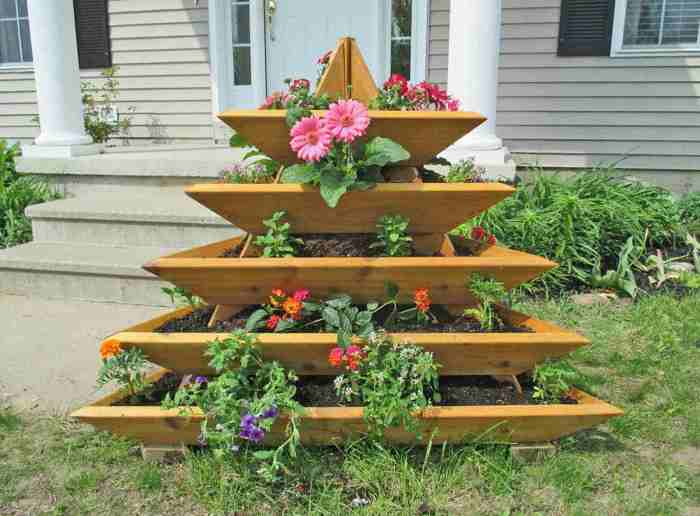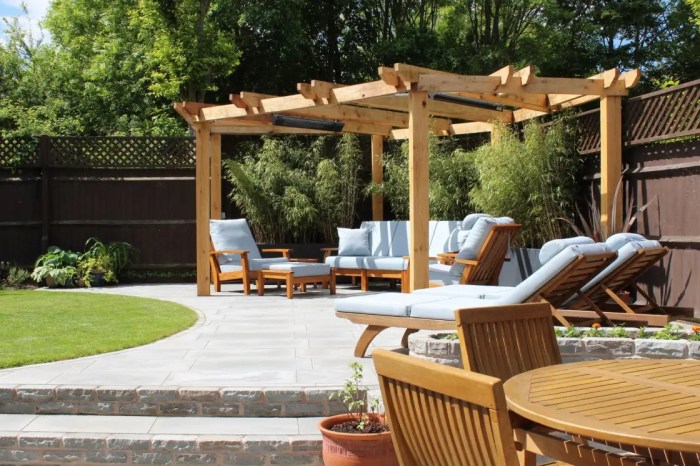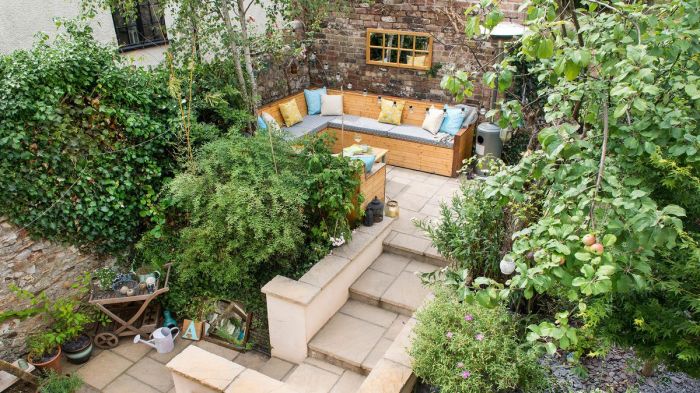Two tiered garden ideas offer a creative and practical solution for gardening enthusiasts, maximizing space while creating a visually stunning outdoor oasis. From design considerations to planting and maintenance techniques, this guide explores the intricacies of two tiered gardens, providing inspiration and guidance for transforming your outdoor space.
With careful planning and execution, two tiered gardens can transform even the smallest of spaces into a thriving and aesthetically pleasing haven, offering a unique and functional approach to gardening.
Design Considerations

Two-tiered garden designs offer numerous advantages, including:
- Improved drainage and aeration for plants.
- Extended growing season by providing microclimates.
- Increased space utilization, allowing for more plants in a smaller area.
- Aesthetic appeal, creating a visually striking and dynamic landscape.
When selecting plants for a two-tiered garden, consider the following:
- Upper Tier:Choose plants that tolerate drier conditions and prefer full sun, such as succulents, herbs, and some vegetables.
- Lower Tier:Select plants that enjoy moisture and shade, such as leafy greens, ferns, and shade-loving flowers.
To create visual interest, vary plant heights and colors. Use taller plants on the upper tier as a backdrop for shorter plants on the lower tier. Consider contrasting colors or foliage textures to create a dynamic and eye-catching display.
Materials and Construction
Two-tiered gardens can be constructed using a variety of materials, including wood, stone, and brick. The choice of material will depend on the desired aesthetic, budget, and available resources.
Wood is a popular choice for two-tiered gardens because it is relatively inexpensive and easy to work with. Cedar and redwood are two types of wood that are naturally resistant to rot and decay, making them ideal for outdoor use.
Stone is another durable option that can create a more formal look. However, stone is more expensive than wood and can be more difficult to work with.
Brick is a third option that is both durable and attractive. However, brick is also more expensive than wood and stone and can be more difficult to work with.
Step-by-Step Instructions for Constructing a Simple Two-Tiered Garden Bed
- Choose a location for your garden that receives at least six hours of sunlight per day.
- Clear the area of any debris or vegetation.
- Build the lower tier of the garden bed by creating a frame out of wood, stone, or brick. The frame should be at least 12 inches high and 24 inches wide.
- Fill the lower tier of the garden bed with a mixture of soil, compost, and manure.
- Build the upper tier of the garden bed by creating a frame that is 6 inches high and 18 inches wide. The frame should be placed on top of the lower tier.
- Fill the upper tier of the garden bed with a mixture of soil, compost, and manure.
- Water the garden bed thoroughly.
It is important to ensure that the garden bed has good drainage. This can be done by adding a layer of gravel or pea gravel to the bottom of the garden bed. It is also important to use a high-quality soil that is rich in organic matter.
Planting and Maintenance
Optimizing plant growth and health in a two-tiered garden requires careful planning and ongoing care. This involves choosing the right planting time, spacing, watering, fertilizing, and pest management strategies for each tier.
Planting Time and Spacing
The ideal planting time depends on the local climate and the specific plants being grown. In general, it’s best to plant in the spring or fall when temperatures are mild. Space plants according to their mature size, ensuring they have enough room to grow without overcrowding.
Watering and Fertilizing
Plants on the upper tier tend to dry out faster than those on the lower tier. Water the upper tier more frequently, especially during hot and dry weather. Fertilize plants regularly according to the manufacturer’s instructions, considering the different nutrient needs of each species.
Pest and Disease Management
Monitor plants regularly for pests and diseases. Use organic methods whenever possible, such as companion planting, beneficial insects, and natural pesticides. Keep the garden clean and well-maintained to prevent disease spread.
Vertical Gardening Techniques
Vertical gardening techniques are an excellent way to maximize space in a two-tiered garden design. By growing plants vertically, you can create a lush and productive garden even in a small area.There are a variety of vertical gardening techniques that you can use, including trellises, hanging baskets, and wall-mounted planters.
Each technique has its own advantages and disadvantages, so it’s important to choose the one that best suits your needs.
Trellises
Trellises are a great way to support climbing plants, such as tomatoes, beans, and cucumbers. They can be made from a variety of materials, including wood, metal, and plastic. Trellises can be freestanding or attached to a wall or fence.
Hanging Baskets
Hanging baskets are a great way to add color and interest to a two-tiered garden. They can be used to grow a variety of plants, including flowers, herbs, and vegetables. Hanging baskets can be hung from a ceiling, a wall, or a tree branch.
Wall-Mounted Planters
Wall-mounted planters are a great way to grow plants in a vertical space. They can be made from a variety of materials, including wood, metal, and plastic. Wall-mounted planters can be attached to a wall or fence.
Space Utilization

Two-tiered gardens offer an ingenious solution to space constraints, allowing gardeners to maximize their growing area even in the most compact spaces.
By stacking two or more tiers vertically, these gardens create a larger surface area for planting without requiring additional ground space. This makes them ideal for balconies, patios, and rooftops, where space is often at a premium.
Incorporating Raised Beds and Containers
Raised beds and containers can be seamlessly integrated into a two-tiered design, further enhancing space utilization. Raised beds provide elevated planting areas, improving drainage and soil conditions while making it easier to reach and maintain plants. Containers, on the other hand, offer versatility and portability, allowing gardeners to move plants around as needed or create specific growing conditions for different species.
Aesthetic Appeal
Two-tiered gardens offer a visually stunning solution to enhance the aesthetic appeal of outdoor spaces. By creating a vertical dimension, they add depth, interest, and a sense of drama to any landscape.
The design possibilities for two-tiered gardens are endless, allowing for customization to complement different styles and preferences.
Formal Gardens
Formal gardens are characterized by their symmetrical design, clean lines, and precise plant placement. Two-tiered gardens can enhance the formality of these spaces by creating a sense of order and balance. The upper tier can be used for taller plants or sculptures, while the lower tier can feature low-growing groundcovers or colorful annuals.
Informal Gardens
Informal gardens, on the other hand, embrace a more relaxed and natural aesthetic. Two-tiered gardens can add a touch of whimsy and charm to these spaces by creating unexpected juxtapositions and incorporating organic shapes. The upper tier can be used for cascading plants or trailing vines, while the lower tier can feature a mix of perennials, shrubs, and wildflowers.
Cottage Gardens
Cottage gardens are known for their abundance of flowers, informal layout, and charming details. Two-tiered gardens can enhance the cottage garden aesthetic by providing additional space for planting and creating a sense of intimacy. The upper tier can be used for climbing roses or other fragrant plants, while the lower tier can feature a mix of herbs, vegetables, and colorful perennials.
Decorative Elements
In addition to plants, two-tiered gardens can be further enhanced with the use of decorative elements. Fountains, sculptures, and lighting can add a touch of elegance or whimsy, depending on the desired style. Fountains can provide a soothing backdrop for relaxation, while sculptures can add a focal point and spark conversation.
Lighting can create a magical ambiance in the evening, highlighting the beauty of the garden even after the sun goes down.
Herb Gardens
Two-tiered herb gardens are a great way to maximize space and grow a variety of herbs. The upper tier can be used for herbs that need more sunlight, while the lower tier can be used for herbs that prefer shade.
Herb Selection
When choosing herbs for your two-tiered herb garden, it is important to consider their sunlight requirements. Herbs that need more sunlight, such as basil, oregano, and thyme, should be planted on the upper tier. Herbs that prefer shade, such as parsley, cilantro, and mint, can be planted on the lower tier.
Companion Planting
Companion planting is a great way to improve the growth and yield of your herbs. When planting herbs together, choose herbs that have complementary growing habits and nutritional needs. For example, basil and tomatoes are a good companion planting because basil helps to repel insects that can damage tomatoes.
Vegetable Gardens: Two Tiered Garden Ideas

Maximize crop yield and extend the growing season with a well-designed two-tiered vegetable garden. Utilize succession planting to ensure a continuous harvest.
Planting Plan
Designate the upper tier for compact, shallow-rooted vegetables like lettuce, spinach, and radishes. The lower tier can accommodate taller, heavier vegetables like tomatoes, peppers, and cucumbers.
Succession Planting, Two tiered garden ideas
Extend the growing season by planting fast-maturing crops, like radishes and lettuce, in early spring. As they mature, replace them with warm-season crops like tomatoes and peppers. This ensures a continuous supply of fresh produce.
Flower Gardens
Incorporate vibrant blooms into your two-tiered garden by creating a dedicated flower paradise. Select a diverse range of flowers suited to different light conditions and tiers, ensuring a continuous burst of colors and textures throughout the seasons.
Suitable Flowers
Consider the following flowers based on their light requirements:
- Full Sun:Zinnias, sunflowers, marigolds, petunias
- Partial Shade:Impatiens, begonias, hostas, astilbes
- Full Shade:Hydrangeas, ferns, foxgloves, hellebores
For a visually stunning design, employ color theory by grouping flowers with complementary or contrasting hues. Experiment with warm tones (reds, oranges, yellows) and cool tones (blues, purples, greens) to create a harmonious or dynamic effect.
Closing Summary
Whether you’re a seasoned gardener or just starting out, two tiered garden ideas provide endless possibilities for creating a beautiful and productive outdoor space. Embrace the vertical dimension, experiment with different plant combinations, and let your creativity shine through as you design a two tiered garden that is both functional and visually captivating.
Common Queries
What are the benefits of two tiered gardens?
Two tiered gardens offer numerous benefits, including maximizing space, improving drainage, enhancing visual appeal, and providing ergonomic gardening.
What materials can be used to build a two tiered garden?
A variety of materials can be used, including wood, stone, brick, and concrete blocks. The choice of material depends on factors such as durability, cost, and aesthetic preferences.
How do I choose the right plants for a two tiered garden?
Consider the amount of sunlight each tier receives, as well as the height and spread of the plants. Taller plants can be placed on the lower tier, while shorter plants and trailing varieties are suitable for the upper tier.


